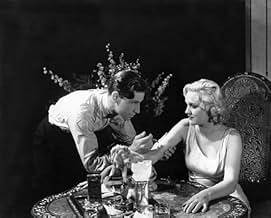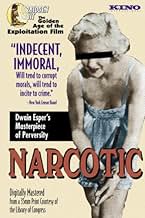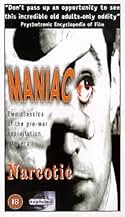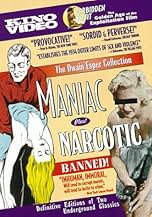Exploitation film which follows the downward spiral of an idealistic medical student whose fall from grace leads him to opium dens, a carnival freakshow, swanky drug parties, dingy brothels,... Read allExploitation film which follows the downward spiral of an idealistic medical student whose fall from grace leads him to opium dens, a carnival freakshow, swanky drug parties, dingy brothels, and finally the barrel of his own revolver.Exploitation film which follows the downward spiral of an idealistic medical student whose fall from grace leads him to opium dens, a carnival freakshow, swanky drug parties, dingy brothels, and finally the barrel of his own revolver.
Herman Hack
- Burger
- (uncredited)
Celia McCann
- Prostitute
- (uncredited)
Elmer McCurdy
- Self
- (uncredited)
Fred Parker
- Policeman
- (uncredited)
Philip Sleeman
- Drug Addict
- (uncredited)
Blackie Whiteford
- Dennison
- (uncredited)
Storyline
Did you know
- TriviaThe film includes an appearance of Elmer McCurdy, an Oklahoma would-be bank robber who was killed in 1911, and whose embalmed body circulated through various sideshows, fun houses and amusement parks for over 60 years. McCurdy's body was not only used as that of a "drug addict" in the film but was put on display by Dwain Esper at screenings of the movie. McCurdy was eventually discovered in a Long Beach (CA) funhouse in 1977 by a film crew for the TV series The Six Million Dollar Man (1974) and he was returned to Oklahoma for proper burial.
- GoofsWhen Davies is persuading his wife that his plan will work, the boom shadow falls the wall behind them. Also, the mike dips briefly into the shot and, and the camera moves forward, the shadow of the accordion-style apparatus used to hoist the mike is also visible, almost distractingly so, on the wall, right behind the wife.
- ConnectionsFeatured in Narcotic Dens of the Orient (1953)
Featured review
Watching Narcotic as a film for its own sake--as an artwork or a piece of entertainment, that is--at this point in time is not entirely satisfactory. For one, it's very choppy. Scenes are missing or truncated oddly, but this is the best print known at the moment. But even if the missing footage were replaced, the film is still uneven. Director Dwain Esper and his wife, writer Hildegarde Stadie, have a bizarre sense of dramatic construction only rivaled by Ed Wood. Esper inserts odd shots for symbolism (such as poisonous snakes, skunks and such near the end), inserts odd intertitles at odd times, and so on. And a lot of the performances intermittently go off the rails. Yet as a historical and sociological oddity, Narcotic is fascinating. Any film buff worth his or her weight in Fassbinder posters should be familiar with it, as should anyone interested in sociology or cultural theory.
I'm not sure if this is the first paranoid anti-drug film, but it must be one of the earlier ones. It beat Esper's similar and more famous Reefer Madness by three years. Additionally, this is much broader in scope than that later film. It's not quite as black and white or ridiculously propagandistic, and it's supposedly based on a true story--a real equivalent to Dr. William G. Davis (played here by Harry Cording), who went on the road hawking "Tiger Fat" (a name only mentioned in intertitles here as far as I could tell), and who was a drug addict stuck in a depressing downward spiral.
The content, which focuses on explicit drug use (including scenes of drug preparation), violence--both accidental and intentional--that remains morally unrectified, serious relationship problems, drug-induced and illicit sexual behavior, and a fantastic, nihilistic ending, may sound like a perfect recipe for a Cheech and Chong film, but in 1933, it was all very challenging. So challenging that the film was rejected twice (once on appeal) by the New York State Film Board. Documentation about this is an interesting special feature on the Kino DVD.
I certainly do not agree with censorship, but the New York State Film Board was astute in some of its criticism of the film. Although viewers could hardly desire ending up like Dr. Davis in the end, many of the scenes are not clearly anti-drug and debauchery. Many scenes seem pro drug and debauchery instead, especially to someone with a hedonistic, libertarian bent, such as myself. They also show basic preparation and administration techniques for drugs.
Although it doesn't seem consistent with their filmographies, Esper and Stadie seem to show pretty explicitly that they're not clearly anti-drug in the comments from "Chinese" character Gee Wu (J. Stuart Blackton, Jr.). Wu presents a pro-opium view early in the film, and through the character, Esper and Stadie suggest that the problem with drugs lies more with cultural differences than in the drugs themselves, even though they seem to backpeddle a bit further into the film.
It's beneficial to keep these kinds of things in mind while watching Narcotic--they'll keep you interested and help stave off Morpheus.
I'm not sure if this is the first paranoid anti-drug film, but it must be one of the earlier ones. It beat Esper's similar and more famous Reefer Madness by three years. Additionally, this is much broader in scope than that later film. It's not quite as black and white or ridiculously propagandistic, and it's supposedly based on a true story--a real equivalent to Dr. William G. Davis (played here by Harry Cording), who went on the road hawking "Tiger Fat" (a name only mentioned in intertitles here as far as I could tell), and who was a drug addict stuck in a depressing downward spiral.
The content, which focuses on explicit drug use (including scenes of drug preparation), violence--both accidental and intentional--that remains morally unrectified, serious relationship problems, drug-induced and illicit sexual behavior, and a fantastic, nihilistic ending, may sound like a perfect recipe for a Cheech and Chong film, but in 1933, it was all very challenging. So challenging that the film was rejected twice (once on appeal) by the New York State Film Board. Documentation about this is an interesting special feature on the Kino DVD.
I certainly do not agree with censorship, but the New York State Film Board was astute in some of its criticism of the film. Although viewers could hardly desire ending up like Dr. Davis in the end, many of the scenes are not clearly anti-drug and debauchery. Many scenes seem pro drug and debauchery instead, especially to someone with a hedonistic, libertarian bent, such as myself. They also show basic preparation and administration techniques for drugs.
Although it doesn't seem consistent with their filmographies, Esper and Stadie seem to show pretty explicitly that they're not clearly anti-drug in the comments from "Chinese" character Gee Wu (J. Stuart Blackton, Jr.). Wu presents a pro-opium view early in the film, and through the character, Esper and Stadie suggest that the problem with drugs lies more with cultural differences than in the drugs themselves, even though they seem to backpeddle a bit further into the film.
It's beneficial to keep these kinds of things in mind while watching Narcotic--they'll keep you interested and help stave off Morpheus.
- BrandtSponseller
- Aug 25, 2006
- Permalink
Details
- Release date
- Country of origin
- Language
- Also known as
- Narcotic Racket
- Filming locations
- See more company credits at IMDbPro
Box office
- Budget
- $8,900 (estimated)
- Runtime57 minutes
- Color
- Sound mix
- Aspect ratio
- 1.37 : 1
Contribute to this page
Suggest an edit or add missing content




























